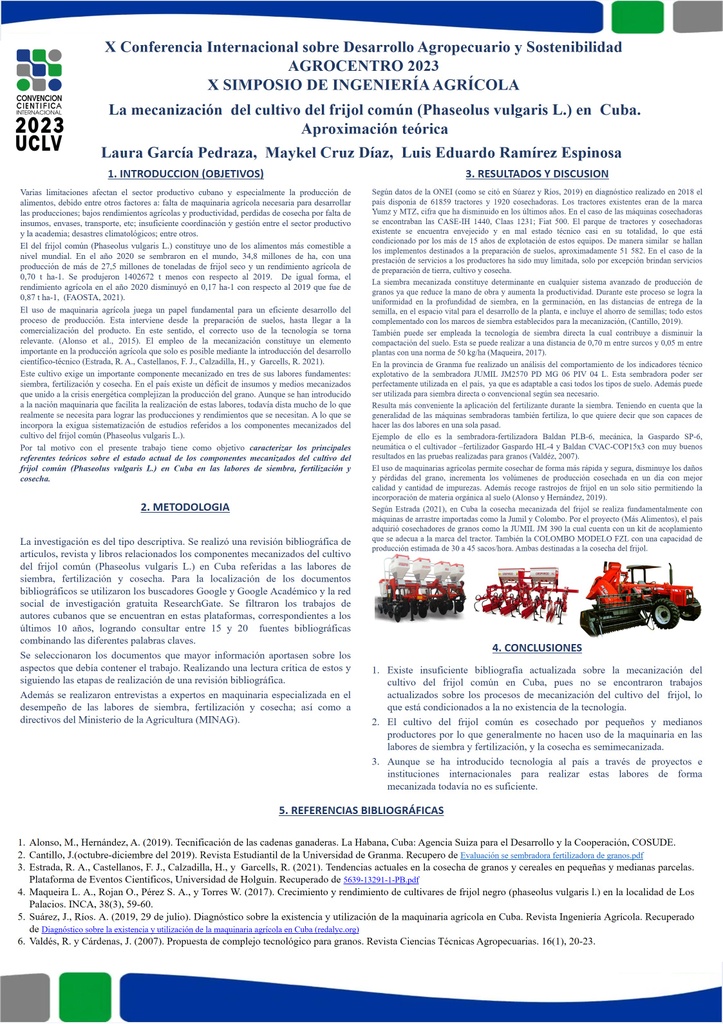Executive Secretary

IX Conferencia Científica Internacional sobre Desarrollo Agropecuario y Sostenibilidad
X Simposio de Ingeniería Agrícola

Resumen
· Problemática: El cultivo frijol común (Phaseolus vulgaris L.) requiere de importantes componentes mecanizados en tres de sus labores fundamentales: siembra, fertilización y cosecha. Aunque se han introducido al país máquinas para realizar de estas labores, son insuficientes su uso y explotación para lograr los rendimientos necesarios. A lo que se incorpora la exigua sistematización de estudios referidos al tema.
· Objetivo(s): Caracterizar los principales referentes teóricos sobre el estado actual de los componentes mecanizados del cultivo del frijol común (Phaseolus vulgaris L.) en Cuba en las labores de siembra, fertilización y cosecha.
· Metodología: Se realizó una revisión bibliográfica de artículos, revista y libros relacionados con el tema en Cuba. Para la localización de los documentos bibliográficos se utilizaron los buscadores Google y Google Académico y la red social de investigación ResearchGate y se filtraron los trabajos de autores cubanos. Así como entrevistas a expertos en maquinaria y directivos del Ministerio de la Agricultura (MINAG).
· Resultados y discusión: La mayoría de los documentos estudiados se enfocan en el mejoramiento de variedades o análisis de rendimientos y no es analizado desde el uso de la mecanización del cultivo. Las labores de siembra y fertilización se realizan generalmente de forma conjunta. La cosecha se realiza de dos formas fundamentales: mecanizada y semimecanizada, aunque la más empleada es la semimecanizada.
· Conclusiones: Existe insuficiente bibliografía actualizada sobre la mecanización del cultivo en Cuba. Este es cosechado por pequeños productores por lo que generalmente no hacen uso de la maquinaria en las labores de siembra y fertilización, y la cosecha es generalmente semimecanizada. Aunque se ha introducido tecnología para realizar estas labores de forma mecanizada todavía no es suficiente.
Abstract
· Problem: The cultivation of common beans (Phaseolus vulgaris L.) requires important mechanized components in three of its fundamental tasks: planting, fertilization and harvesting. Although machines have been introduced to the country to carry out these tasks, their use and exploitation are insufficient to achieve the necessary performance. To which is incorporated the meager systematization of studies related to the subject.
· Objective(s): Characterize the main theoretical references on the current state of the mechanized components of common bean (Phaseolus vulgaris L.) cultivation in Cuba in sowing, fertilizing and harvesting tasks.
· Methodology: A bibliographic review of articles, magazines and books related to the topic in Cuba was carried out. To locate the bibliographic documents, the Google and Google Academic search engines and the ResearchGate social research network were used and the works of Cuban authors were filtered. As well as interviews with machinery experts and managers of the Ministry of Agriculture (MINAG).
· Results and discussion: Most of the documents studied focus on the improvement of varieties or analysis of yields and are not analyzed from the use of crop mechanization. Planting and fertilizing tasks are generally carried out jointly. Harvesting is done in two fundamental ways: mechanized and semi-mechanized, although the most widely used is semi-mechanized.
· Conclusions: There is insufficient updated bibliography on the mechanization of cultivation in Cuba. This is harvested by small producers, so they generally do not use machinery in planting and fertilization tasks, and the harvest is generally semi-mechanized. Although technology has been introduced to carry out these tasks mechanized, it is still not enough.
Sobre el ponente

MsC. Laura García Pedraza

Discussion

